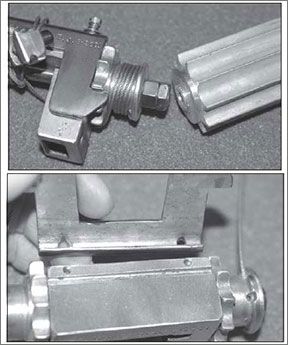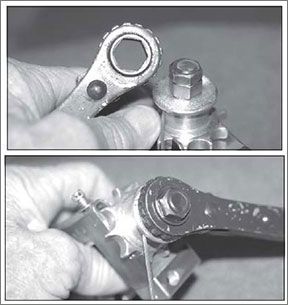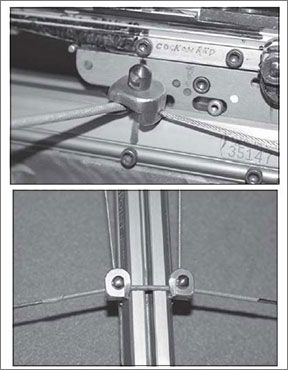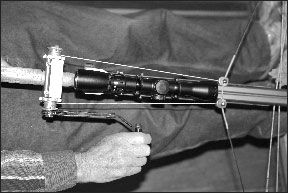
288
While observing a number of different crossbows being cocked, I could clearly see a need for a better way this could be accomplished. Cocking a 150-175 pound crossbow via direct pull, with both hands, requires considerable strength. The next easiest method is performed by means of a rope cocking aid utilizing a long cord with T-handles on each end fitted to a pair of pulleys that doubled back to the bow frame to reduce pull weight by 50 percent. Though substantially easier, this too can be quite difficult for the aging or incapacitated hunter who really needs help.As alternatives for easier crossbow cocking, there are various methods of cranking the bow by means of a pulley and hand crank. Most of these are quite effective but not totally uncomplicated to operate and most are noisy out in the woods. They are usually set up to work on one style of crossbow only. There also are specialized cocking systems using gas cylinders and electrical devices rigged to individual crossbows that can be quite expensive.This was sufficient to inspire the design of a universal crank-cocking system that could be adapted to a number of different crossbows, one that is safe, quiet and easy to carry and attach.Universal Crank System -Through close observation of the dynamics involved in cocking a crossbow, I was able to design a crossbow crank cocking system requiring but a fraction of the strength needed for direct hand cocking, or even the use of a rope cocking aid.The crank operated unit, made chiefly of cast aluminum, weighs only 1.5 pounds, fits in a man’s hand and carries in a small pack. Only 15 seconds are required to reach into the pack and attach the crank system to the crossbow. The crossbow can then be silently cocked in less than 20 seconds. A close study of the pictures and the following directions will show how a capable machinist or gunsmith could quite easily duplicate my efforts in making this or a very similar crank cocking system staying essentially within the basic principles of design I have outlined.The frame is made from a piece of cast aluminum 2 3/4 inches wide x 2 1/4 inches high x 1 1/4 inches thick. A square opening is cut upwards from the bottom 1 5/8 inches deep x 1 1/4 inches wide. This provides for an opening into the aluminum anchoring block which is later fitted at correct height into the stock so the bottom border of the cable spool is on the same plane as the main beam of the crossbow that guides the bow string.

288
A 3/8-inch hole was drilled through the topside of the frame 1/2 inch from the top. This allows the bottom radius of the shaft to lock into the stock anchor block as it rotates. The assembled unit is also locked to the stock anchor block from below with a 1/4 inch removable push pin. The two laterally opposing sprocket cable spools are made from cast aluminum 41-10-tooth sprocket stock material. As machined, these work perfectly as cable wind spools with integral ratchet locks.A cable wind spool surface 1/2 inch wide x 3/16 inch deep is then formed into the outer side of each cable spool. A central hole is drilled and tapped through the sprocket spools to receive the 3/8 inch threaded bolt ends. These work to later solidly lock the sprocket locking spools to the threaded ends of the 3/8 inch through bolts. The bolt ends are threaded to a thread depth allowing only for a flush fit as the two sprocket spools are later torqued into place onto the bolts . A 3/8-16 hex nut is screwed on the left end of the protruding bolt and tightened firmly to prevent spool/sprocket slippage.The right side sprocket spool is screwed in place firmly against the bolt threads until the sprocket teeth are timed together. Once the sprockets are timed together, securely tighten two nuts against the sprocket spool on the right side to torque things in place. The two aligned nuts will then fit the ratchet crank handle.Ratchet Cable Lock And Release -A piece of 0.075-inch plate steel is used to make the cable sprocket lock and release. The locking plate fits between and into the sprocket teeth with cutout to fit the frame opening. It is attached above via a 5/16 inch rolled curve radius hooked into the top of the plate and pivots in a groove made across the outer top of the frame. Two spring loaded 8-32 screws pass through the upper curved radius keeping the two spring locks positively against each sprocket tooth as the crank is turned to wind the cable. These same lock wings are used to release the ratchet after the bow is fully cocked, releasing the bowstring. Two thin pads are attached under the steel plate for silent operation.

288
Cable, Crank and Hooks -I made up a seven inch long reversible, open end ratchet wrench handle to fit the 3/8 inch hex nuts. The ratchet wrench enables the user to make partial turns of the crank while cocking and releasing the crossbow winding cables. This permits full leverage and control of the crank with minimal arm movement if desired. Special bowstring hooks are made of brass to attach the lower cable ends to the bowstring. The pictures show the simplicity of this design, first featured in the November 2011 issue of American Gunsmith. The string hooks must be polished to prevent bowstring abrasion or scuffing of the side of the crossbow beam.With spools and bowstring hooks ready, the proper length and type of cable joins the two. I used 0.065 diameter, 7×7 49-strand cable, which is very strong, flexible and resistant to bending or kinking. This is much better than the commonly seen fabric cord used in most bow-crank systems. Cable attaching holes were drilled at an angle into the winding spools, set to correct length and secured with countersunk socket head set screws. There is some cable length leeway permitted allowing the bowstring to be pulled back for cable hook attachment. It is important that the cable/bowstring hooks are set to the same length so they pull evenly as the bow is cocked.Trying The Cocking Crank -This crossbow crank cocking system is very easy to use but a few things need to be checked beforehand. Some crossbow safeties are laterally positioned on the same plane as the string and may need to be shortened to allow free passage of the bowstring hooks. Most safeties are moved to the rearward safe position automatically as the bow is cocked. Dry firing will not occur with this crank cocking system with its independent cables. If one cable fails, the other will hold the string, Incidentally, dry firing occurs when a bowstring is released without an arrow and this can damage a bow. Never draw the string of any crossbow beyond the fully cocked position into the sear.Correct cocking can clearly be seen and heard as the bow is being cocked. As a bow is fully cocked, be sure the safety is in the ON-SAFE position. The bowstring hooks can then be released by relaxing the string. While a crossbow can be uncocked using this or other crank systems, it is not recommended. The usual way is to shoot an arrow into the dirt or other safe backstop. Most hunters use an old or damaged arrow for this purpose.Crossbows are inherently safe and quite easy to use if used as designed. As with firearms, reasonable precautions must always be practiced in the use of a crossbow and its accessories while cocking, handling and shooting. The safety of any firearm or crossbow should not be released until ready to shoot.

288
Though the crossbow has increased in popularity, with extended hunting seasons in many states, permits are often limited to older and disabled persons. Not all shooting aids have kept up with the times, making some crossbows difficult to use. Anything that can be done to make the crossbow easier to use must be considered. Whether purchased or built by a machinist/gunsmith or hunter, any form of improved cocking system ranks very high on the list. AG
Click here to see American Gunsmith’s Website
Click here to subscribe to American Gunsmith




























